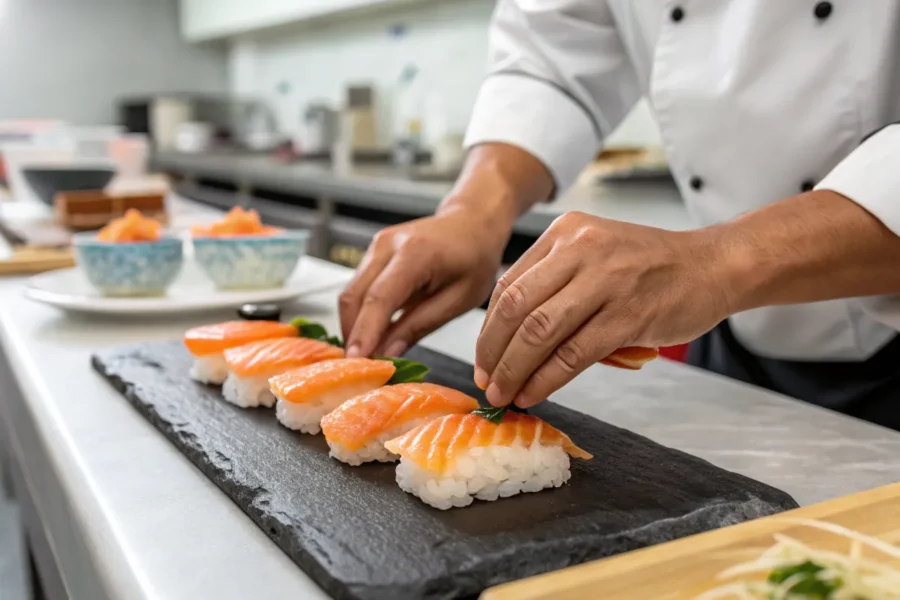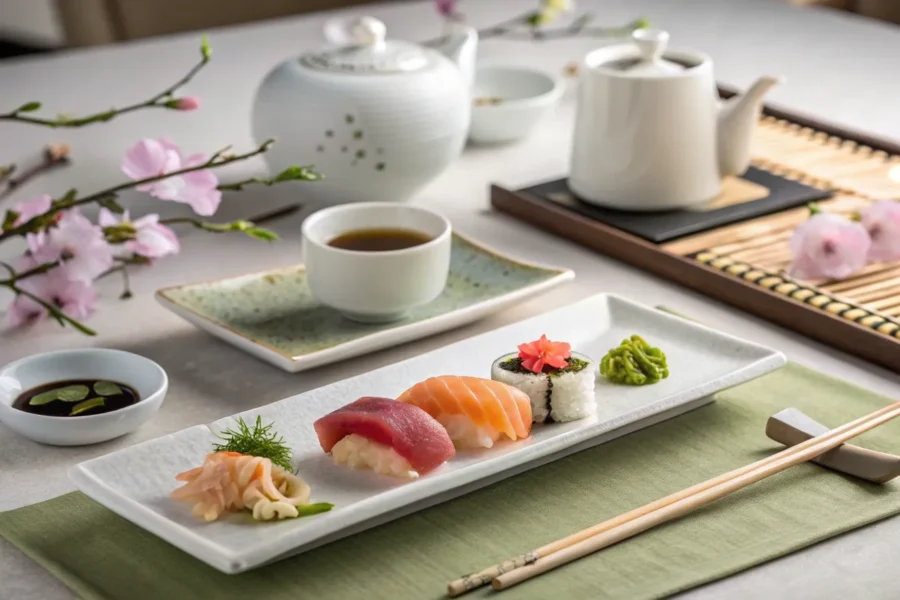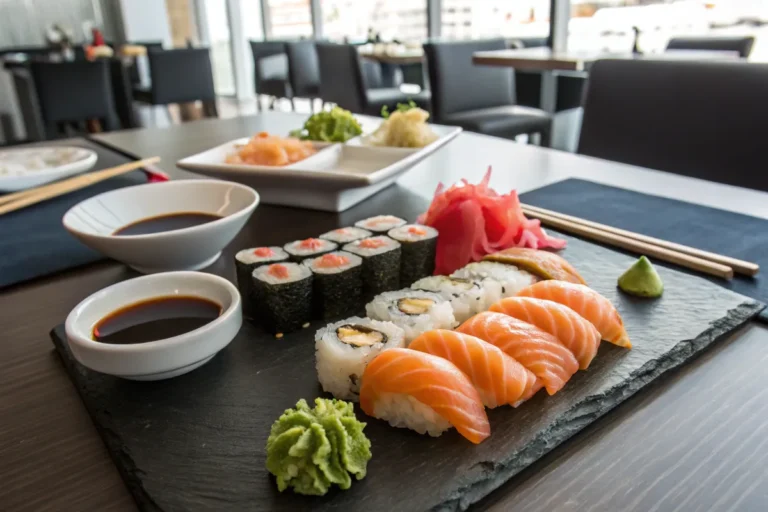Japanese cuisine has captured hearts worldwide, with dishes like sushi, nigiri, and sashimi stealing the spotlight. But while many people are familiar with these names, the distinctions between nigiri and sashimi often spark curiosity. Are they both sushi? Is rice involved? What’s the best way to enjoy them? In this article, we’ll dive into these questions, explore their origins, and compare their unique qualities, from preparation methods to health benefits.
Let’s unravel the mystery of nigiri vs sashimi and discover why these two culinary staples continue to charm diners globally.
Table of Contents
Introduction to Nigiri and Sashimi
What Are Nigiri and Sashimi?
At first glance, nigiri and sashimi might look similar, thanks to their shared focus on fresh seafood. But they’re fundamentally different. Nigiri is a type of sushi featuring bite-sized balls of vinegared rice topped with a slice of raw or cooked fish. It’s often garnished with a hint of wasabi or wrapped in a strip of nori (seaweed).
Sashimi, on the other hand, is all about simplicity and precision. It’s pure artistry: thin slices of raw fish or meat served without rice. Instead, sashimi is typically accompanied by soy sauce, pickled ginger, and daikon radish to enhance its flavors.
Why These Japanese Culinary Staples Matter
Nigiri and sashimi aren’t just food they’re cultural symbols, embodying Japan’s dedication to freshness, balance, and minimalism. These dishes celebrate the natural flavors of seafood, showcasing high-quality ingredients with minimal embellishments. Their preparation requires years of training, making them a testament to Japanese chefs’ craftsmanship.
From fine dining experiences to casual sushi bars, nigiri and sashimi have become global ambassadors of Japanese cuisine. Whether you’re a sushi aficionado or just dipping your toes into this culinary world, understanding these dishes enhances your appreciation of their artistry and flavor.
The Core Differences Between Nigiri and Sashimi

Composition: Rice and Raw Fish
The most significant distinction in nigiri vs sashimi is the inclusion of rice. Nigiri, a subset of sushi, features hand-pressed vinegared rice topped with slices of fresh fish or seafood. Sometimes, the toppings are lightly seared or paired with wasabi for added flavor.
Sashimi, on the other hand, skips the rice entirely. It focuses solely on high-quality raw fish or meat, sliced into thin, delicate pieces. The purity of sashimi highlights the ingredient’s natural taste and texture, often enhanced with soy sauce, grated ginger, or pickled vegetables.
Presentation Styles and Ingredients
When it comes to presentation, nigiri is compact and structured, with toppings often secured by a thin strip of seaweed. Popular choices for nigiri toppings include tuna, salmon, and shrimp, but modern variations might incorporate egg, avocado, or cooked eel.
Conversely, sashimi showcases minimalism. Arranged artistically, it’s served on a bed of shredded daikon radish or garnished with edible flowers. This dish often features fish like salmon, yellowtail, and squid, but non-fish options like beef or tofu also make appearances.
Cooking Variations and Techniques
Though sashimi is strictly raw, nigiri offers more flexibility. It may include cooked or lightly seared elements, like torched scallops or grilled eel. Chefs use precise knife skills and traditional techniques to ensure each piece of nigiri or sashimi delivers the perfect bite.
Sushi vs Nigiri vs Sashimi: Key Comparisons
Defining Sushi and Its Subtypes
To fully understand what is nigiri vs sashimi, it’s helpful to first grasp sushi. Sushi isn’t just about raw fish it refers to dishes centered around vinegared rice. This includes maki (rolled sushi), temaki (hand rolls), and nigiri. While nigiri falls under the sushi umbrella, sashimi stands apart due to its rice-free approach.
Differences in Dining Experiences
Dining on nigiri and sashimi offers unique experiences. Nigiri provides a satisfying contrast between the soft rice and tender fish, enhanced by subtle seasonings. It’s often served in pairs, ideal for sharing or sampling different flavors.
Sashimi, however, is about appreciating the raw ingredient’s natural essence. Each slice is a testament to the chef’s knife skills and the ingredient’s quality. Pairing it with soy sauce and wasabi intensifies its umami flavors, making every bite memorable.
For a similar fusion of flavors, check out ginger and garlic dishes, which balance bold and delicate tastes beautifully.
Health and Nutritional Aspects
Calories in Nigiri and Sashimi
When considering what is nigiri vs sashimi, it’s worth noting their distinct nutritional profiles. Nigiri, with its base of vinegared rice, typically contains more calories than sashimi. For instance, a single piece of salmon nigiri has around 50 calories, while the same portion of sashimi clocks in at about 25 calories.
The addition of rice in nigiri increases carbohydrate content, providing a quick energy boost. This makes it a great option if you’re seeking a heartier dish. In contrast, sashimi offers a lighter, low-carb alternative that’s perfect for those focusing on protein intake.
Protein, Fats, and Omega-3 Benefits
Both dishes are excellent sources of lean protein, essential for muscle growth and repair. Additionally, fish like salmon and tuna commonly used in nigiri and sashimi are rich in omega-3 fatty acids. These healthy fats support brain health, reduce inflammation, and promote cardiovascular wellness.
Cultural and Historical Perspectives
Origins of Nigiri and Sashimi
To understand what is nigiri vs sashimi, exploring their origins sheds light on their unique roles in Japanese cuisine. Sashimi is believed to be one of the oldest forms of preparing raw fish in Japan, with a history dating back over a thousand years. Initially, it was a delicacy enjoyed by the elite, prized for its pure and fresh flavors.
Nigiri, on the other hand, emerged during the Edo period (1603–1868) in Tokyo, then known as Edo. It was developed as a quick and portable snack for busy city dwellers. With the addition of vinegared rice and fresh fish, nigiri became an early form of “fast food,” perfect for on-the-go consumption.
Evolution and Modern Adaptations
Over time, both dishes have evolved significantly. Today, chefs worldwide have embraced sashimi, experimenting with non-traditional ingredients like beef and even vegetables. Similarly, nigiri has seen creative adaptations, incorporating ingredients like truffle oil, caviar, or avocado to cater to modern palates.
Despite these innovations, the essence of both dishes remains rooted in simplicity and respect for the ingredients. This focus on freshness and balance continues to captivate diners globally.
How to Enjoy Nigiri and Sashimi Like a Pro

Choosing the Best Ingredients
To truly savor nigiri and sashimi, start by choosing high-quality ingredients. Look for fish that’s labeled as “sushi-grade” or “sashimi-grade.” These terms indicate the fish has been handled and frozen to eliminate parasites, ensuring it’s safe for raw consumption.
If preparing these dishes at home, visit a trusted fishmonger. They can guide you in selecting the freshest options, whether you’re crafting traditional nigiri or experimenting with modern sashimi creations.
Pairing with Drinks and Sides
Pairing is essential to enhance the flavors of nigiri and sashimi. Traditional sides like soy sauce, wasabi, and pickled ginger cleanse the palate and complement the seafood’s umami notes.
When it comes to drinks, sake is a classic choice. Its subtle sweetness pairs beautifully with the clean, delicate flavors of both dishes. For a non-alcoholic option, green tea provides a refreshing counterpart.
Mastering the art of enjoying these dishes not only elevates your dining experience but deepens your appreciation for Japanese culinary traditions. Whether you’re dining out or experimenting in your kitchen, understanding what is nigiri vs sashimi transforms every bite into a celebration of flavor and craftsmanship.
The Global Popularity of Nigiri and Sashimi
How Nigiri and Sashimi Gained Worldwide Recognition
The question what is nigiri vs sashimi isn’t confined to Japan anymore it’s asked in sushi bars and fine dining establishments worldwide. Globalization and the rise of Japanese cuisine’s popularity have turned these dishes into culinary icons.
Sushi restaurants began spreading internationally in the mid-20th century, especially in cities like Los Angeles and New York. Their success was driven by adventurous diners eager to explore exotic flavors. Nigiri and sashimi quickly became the stars of these menus, celebrated for their simplicity and emphasis on fresh, high-quality ingredients.
How Different Cultures Have Embraced These Dishes
In the West, chefs have embraced fusion techniques, adding their unique twists to nigiri and sashimi. You’ll often find creative versions with non-traditional ingredients like avocado, truffle oil, or even jalapeños. In some places, vegetarian and vegan options, featuring tofu or mock seafood, have also become popular.
Despite these variations, the integrity of nigiri and sashimi as artful dishes remains intact. Their universal appeal lies in their ability to highlight the beauty of fresh, simple ingredients.
Tips for First-Timers Enjoying Nigiri and Sashimi
Dining Etiquette and Customs
For those new to Japanese cuisine, understanding basic etiquette enhances the dining experience. When eating nigiri, dip only the fish not the rice into soy sauce to avoid overwhelming the flavors. Similarly, use wasabi sparingly; its purpose is to accentuate the fish, not overpower it.
With sashimi, use chopsticks or the provided utensils to handle the pieces delicately. Accompany each bite with a touch of soy sauce or pickled ginger to cleanse your palate between flavors.
How to Expand Your Palate
First-timers often wonder, “Where should I start?” Salmon and tuna are mild, beginner-friendly options for both nigiri and sashimi. Gradually, you can explore more adventurous choices like mackerel, eel, or even octopus.
It’s also a good idea to ask your chef or server for recommendations. Many sushi bars offer omakase-style dining, where chefs curate a selection tailored to your taste preferences. This allows you to experience the best of what is nigiri vs sashimi without feeling overwhelmed.
By embracing these tips, your journey into Japanese cuisine will be both enjoyable and enriching.
FAQs
How Many Calories Are in One Piece of Salmon Nigiri?
One piece of salmon nigiri typically contains about 50 calories. This includes the caloric contribution from the vinegared rice and the slice of fresh salmon. However, portion size and preparation can slightly affect this number.
Is Sashimi Healthier Than Nigiri?
If you’re watching your carb intake, sashimi is the healthier choice. Without rice, it’s lower in calories and focuses on delivering pure, high-quality protein. On the other hand, nigiri offers a more balanced energy source, combining carbs and protein in one bite.
What Types of Fish Are Most Commonly Used for Sashimi?
The most popular options for sashimi include salmon, tuna, yellowtail, and mackerel. Non-fish choices, such as octopus, scallops, and even wagyu beef, provide variety and cater to diverse palates.
Can Nigiri Be Made Without Seafood?
Yes! Vegetarian nigiri options are growing in popularity. Ingredients like avocado, egg (tamago), and even tofu can replace fish, providing a unique twist on this classic dish.
For more culinary tips and creative ideas, explore other recipes on our website. They’re perfect for anyone eager to experiment in the kitchen!
Conclusion: Celebrating the Artistry of Nigiri and Sashimi
From their rich cultural heritage to their meticulous preparation, nigiri and sashimi embody the essence of Japanese cuisine. While they share common elements like the focus on fresh, high-quality ingredients they each offer unique dining experiences that cater to different tastes and preferences.
Understanding what is nigiri vs sashimi not only deepens your appreciation of these dishes but also helps you enjoy them with confidence. Whether you’re savoring the perfect bite of nigiri with vinegared rice or relishing the purity of sashimi, these culinary treasures promise to delight your palate.
As you explore these timeless classics, remember to respect the traditions behind them while embracing modern twists that make them accessible to all. Here’s to enjoying every flavorful bite of these Japanese culinary masterpieces!

